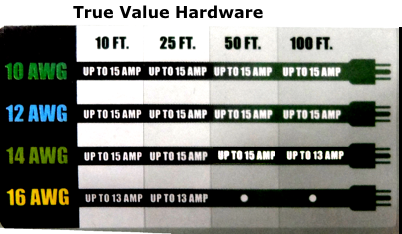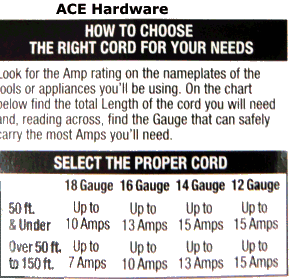 Home - Garden
Home - Garden
 Electrical
Electrical
 Wire
Wire
Don's Home
 Home - Garden
Home - Garden
 Electrical
Electrical
 Wire
Wire
|
|
Voltage Drop | Recommended Size | Prices | The National Electric Code (NEC) sets limits on the amount of current that cords are permitted to carry. This is for safety, to prevent overheating the cord. The limits for common cords are given in the chart below:
AWG general rules of thumb - for every 6 gauge decrease, the wire diameter doubles and for every 3 gauge decrease, the cross sectional area doubles. Source: Ampacities for wire Voltage Drop: As important as overheating is voltage drop based resistance due to size and length of the cord. Remember your physics? Ohm's Law,  or V = I R1, says current (amperes) (I) is potential difference (volts) (I) divided by resistance (ohms) (R). or V = I R1, says current (amperes) (I) is potential difference (volts) (I) divided by resistance (ohms) (R).E.g. If you apply 120 volts to a circuit with a resistance of 10 Ohms you will get 12 amps of current. Most of the resistance in electrical appliances, motors, light bulbs, etc. is in the appliance, but the wire in your house and extension cords also increase resistance. Temperature and resistance: Resistance goes down in colder temperature. Ohms per 1000 ft.
Long runs of wire can have an significant effect on the voltage delivered to the appliance. A 100 ft. cord will have twice the resistance of a 50 ft. cord.
Recommended Extension Cord Size (120 v)
| |||||||||||||||||||||||||||||||||||||
 Home Depot
|
 Maximum voltage drop based on recommendations
| ||||||||||||||||||||||||||||||||||||
|
Voltage drop in the cord often doesn't allow the power tools to run at full speed. This causes them to heat up and can inflict damage to them.
Electrical equipment is designed to operate at within a given voltage range, typically no less than 10% and no more than 5% from it's voltage rating.
Note 1: There is some voltage drop in your house wiring. 6% with a 13 amp motor from my circuit breaker to my garage with 14 gauge - 15 amp circuit.
Amps Voltage drop with 10 amp load
Outlet by Circuit breaker 10.6 119 to 115 3%
Outlet in garage 9.9 115 to 107 7%
Note 2: Freezing weather will reduce voltage drop by about 10%. See below.
Buying Guide: Extension Cords | at The Home Depot Calculate Extension Cord Voltage Drop
Some sites say,
How to Select the Right Extension Cord
Two cords of noticeably different thickness may have exactly the same copper wire (and therefore current capacity) inside them. Notice in the photo of examples at right that one of the #16 AWG cords is thicker than the #14 AWG cord below it. See "Cord Marking" below for more details.
Cord Marking The marking item that usually follows the wire gauge tells us the type of cord, meaning the physical construction. The two types of construction likely to be found are "S" (hard service) and "SJ" (the J is for "junior," a lighter duty, less-rugged version of the type S cord. (Both types are shown in the photo.) Additional letters may follow the S or SJ. The additional letters indicate other performance characteristics. Here are some:
Source: Choosing and Using Extension Cords | home.mchsi.com/~gweidner
1. In most physics books, "I" is used as the symbol for electric current because in the early scientific days it was known as Electrical Intensity.
When the facts about electric current and electrons were discovered the letter C had already been used for Capacitance so the letter I was retained.
Other Considerations:
Prices:
Note: Multiple outlets are convenient for connecting multiple tools like drills, chargers, ..., but inconvenient for use with something like a leaf blower.
Links: | |||||||||||||||||||||||||||||||||||||